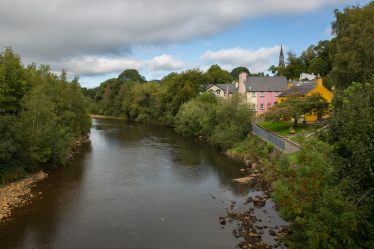Avoca

Avoca village dates primarily from the 19th century and its growth and development were influenced by the nearby mines. It stretches in linear fashion along the eastern bank of the Avoca river from the three-arch bridge, which was built in 1868, uphill to the Catholic Church of St. Mary & St. Patrick, constructed just six years beforehand. Further along the street is Avoca Mills complex. This was originally a corn and flour mill before become a noted site for hand weaving fine garments. The railway line came through Avoca in the 1860s and the station was located on the opposite bank of the river.
The origin of the name Avoca has been the subject of much discussion. The ancient Greek geographer Ptolemy included a river name ‘Oboca’ on his map of Ireland from the second century AD, which might infer that the name of the village and river is of extremely ancient origin. However, Avoca was known as Newbridge until the mid-19th century, and there are no references to the placename Avoca in Irish sources prior to then.
One of the best ways to explore the village and its surrounds is by taking the Red Kite walking trail, a 2.5km loop which ascends the forested high ground of Kilmagig Woods to the east of the village. The walk takes its name from a recent initiative to reintroduce the Red Kite to the area. The project commenced in 2009 and has been a great success; now this bird of prey can be regularly seen soaring in the skies above the valley.
The former courthouse in the village centre is a relatively modest building dating from around 1870, but it retains an important function today as a heritage and tourist information centre. Avoca was the location for the filming of the BBC television series Ballykissangel, which originally aired from 1996 to 2001. The village retains pride in its links with the popular show and this is reflected in the names of several local businesses.
One of the most iconic denizens of the village is Avoca Handweavers. First established in 1723, this is the oldest working woollen mill in Ireland. The mill was initially used to grind flour, as well as to spin and weave wool, but after the mill owners invested in a fly-shuttle loom in the 1760s wool became the primary focus. The loom was capable of weaving up to 20 metres of cloth every day. This effciency was a threat to employment of the local weavers, who reportedly resorted to burning some looms.
After the three Wynne sisters inherited the business in the 1920s, they introduced colour to the previously plain patterns. Avoca Handweavers tweeds was produced and exported, including for use by Italian designer Elsa Schiaparelli. The material was also used for a waistcoat for King George VI and baby blankets for the children of Queen Elizabeth II.




No Comments
Add a comment about this page